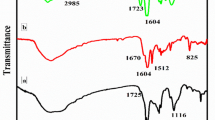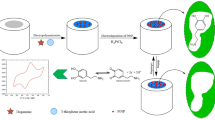Abstract
The dopamine-imprinted conducting polymer film of 5-amino 8-hydroxy quinoline (AHQ) was electrodeposited on reduced graphene oxide (rGO)-modified glassy carbon (GC) electrode and was applied as a molecular recognition element for the selective determination of dopamine. The molecularly imprinted polymer (MIP)-modified electrode showed an excellent affinity towards dopamine due to the presence of imprinted site through hydrogen bonding interaction between dopamine and poly (AHQ) membrane. The molecular recognition ability of MIP-modified electrode was analyzed by cyclic voltammetric and differential pulse voltammetric techniques. The most stable geometry of the template–monomer complex in the pre-polymerization mixture was calculated by computational approaches. The rGO modification augmented both surface area and electron transfer kinetics of the bare electrode. The GC/rGO/MIP electrode possessed 2.83 fold current enhancements when compared to GC/MIP electrode, indicating the improvement in sensitivity due to rGO modification. The limit of detection and sensitivity of GC/rGO/MIP electrode was observed to be 32.7 nM and 13.3 AM−1 cm−2, respectively. The imprinting methodology provided an exceptional selectivity towards the detection of dopamine even in the presence of high concentration of possible physiological interferents. Moreover, the fabricated electrode was successfully employed for the detection of dopamine in human blood plasma samples proving the effectiveness of the sensor for the sensitive detection of dopamine from real samples.





Similar content being viewed by others
References
Bergquist J, Ściubisz A, Kaczor A, Silberring J (2002) Catecholamines and methods for their identification and quantitation in biological tissues and fluids. J Neurosci Methods 113(1):1–13
Jääskeläinen SK, Rinne JO, Forssell H, Tenovuo O, Kaasinen V, Sonninen P, Bergman J (2001) Role of the dopaminergic system in chronic pain–a fluorodopa-PET study. Pain 90(3):257–260
Wood PB, Schweinhardt P, Jaeger E, Dagher A, Hakyemez H, Rabiner EA, Bushnell MC, Chizh BA (2007) Fibromyalgia patients show an abnormal dopamine response to pain. Eur J Neurosci 25(12):3576–3582
Červenka S, Pålhagen SE, Comley RA, Panagiotidis G, Cselényi Z, Matthews JC, Lai RY, Halldin C, Farde L (2006) Support for dopaminergic hypoactivity in restless legs syndrome: a PET study on D2-receptor binding. Brain 129(8):2017–2028
Mahanthesha K, Swamy BK (2013) Pretreated/Carbon paste electrode based voltammetric sensors for the detection of dopamine in presence of ascorbic acid and uric acid. J Electroanal Chem 703:1–8
Rubianes M, Rivas G (2001) Highly selective dopamine quantification using a glassy carbon electrode modified with a melanin-type polymer. Anal Chim Acta 440(2):99–108
Ekinci E, Erdoğdu G, Karagözler AE (2001) Preparation, optimization, and voltammetric characteristics of poly (o-phenylenediamine) film as a dopamine-selective polymeric membrane. J Appl Polym Sci 79(2):327–332
Wang X, Yang N, Wan Q, Wang X (2007) Catalytic capability of poly (malachite green) films based electrochemical sensor for oxidation of dopamine. Sens Actuators, B 128(1):83–90
Lin X, Zhuang Q, Chen J, Zhang S, Zheng Y (2007) Electrocatalytic property of poly-chromotrope 2B modified glassy carbon electrode on dopamine and its application. Sens Actuators, B 125(1):240–245
Kang T-F, Shen G-L, Yu R-Q (1997) Voltammetric behaviour of dopamine at nickel phthalocyanine polymer modified electrodes and analytical applications. Anal Chim Acta 354(1):343–349
Cao X, Luo L, Ding Y, Zou X, Bian R (2008) Electrochemical methods for simultaneous determination of dopamine and ascorbic acid using cetylpyridine bromide/chitosan composite film-modified glassy carbon electrode. Sens Actuators, B 129(2):941–946
Alexander C, Andersson HS, Andersson LI, Ansell RJ, Kirsch N, Nicholls IA, O’Mahony J, Whitcombe MJ (2006) Molecular imprinting science and technology: a survey of the literature for the years up to and including 2003. J Mol Recognit 19(2):106–180
Sallacan N, Zayats M, Bourenko T, Kharitonov AB, Willner I (2002) Imprinting of nucleotide and monosaccharide recognition sites in acrylamidephenylboronic acid–acrylamide copolymer membranes associated with electronic transducers. Anal Chem 74(3):702–712
Chou LC, Liu C-C (2005) Development of a molecular imprinting thick film electrochemical sensor for cholesterol detection. Sens Actuators, B 110(2):204–208
Gómez-Caballero A, Unceta N, Goicolea MA, Barrio RJ (2008) Evaluation of the selective detection of 4, 6-dinitro-o-cresol by a molecularly imprinted polymer based microsensor electrosynthesized in a semiorganic media. Sens Actuators, B 130(2):713–722
Prasad K, Prathish K, Gladis JM, Naidu G, Rao TP (2007) Molecularly imprinted polymer (biomimetic) based potentiometric sensor for atrazine. Sens Actuators, B 123(1):65–70
Özcan L, Şahin Y (2007) Determination of paracetamol based on electropolymerized-molecularly imprinted polypyrrole modified pencil graphite electrode. Sens Actuators, B 127(2):362–369
Jorn C, Krushkova S, Lai EP, Dabek-Zlotorzynska E (2005) Molecularly-imprinted polypyrrole-modified stainless steel frits for selective solid phase preconcentration of ochratoxin A. Anal Bioanal Chem 382(7):1534–1540
Novoselov KS, Geim AK, Morozov SV, Jiang D, Zhang Y, Dubonos SV, Grigorieva IV, Firsov AA (2004) Electric field effect in atomically thin carbon films. Science 306(5696):666–669
Zhou M, Wang Y, Zhai Y, Zhai J, Ren W, Wang F, Dong S (2009) Controlled synthesis of large-area and patterned electrochemically reduced graphene oxide films. Chemistry–A. Eur J 15(25):6116–6120
Shan C, Yang H, Song J, Han D, Ivaska A, Niu L (2009) Direct electrochemistry of glucose oxidase and biosensing for glucose based on graphene. Anal Chem 81(6):2378–2382
Wu L-N, Tan Y-L, Wang L, Sun S-N, Qu Z-Y, Zhang J-M, Fan Y-J (2015) Dopamine sensor based on a hybrid material composed of cuprous oxide hollow microspheres and carbon black. Microchim Acta 182(7):1361–1369. https://doi.org/10.1007/s00604-015-1455-2
Karikalan N, Velmurugan M, Chen SM, Chelladurai K (2016) A copper hexacyanocobaltate nanocubes based dopamine sensor in the presence of ascorbic acid. RSC Adv 6(54):48523–48529. https://doi.org/10.1039/C6RA05810H
Jia L, Zhou Y, Jiang Y, Zhang A, Li X, Wang C (2016) A novel dopamine sensor based on Mo doped reduced graphene oxide/polyimide composite membrane. J Alloy Compd 685:167–174. https://doi.org/10.1016/j.jallcom.2016.05.239
Zhao D, Yu G, Tian K, Xu C (2016) A highly sensitive and stable electrochemical sensor for simultaneous detection towards ascorbic acid, dopamine, and uric acid based on the hierarchical nanoporous PtTi alloy. Biosens Bioelectron 82:119–126. https://doi.org/10.1016/j.bios.2016.03.074
Mao H, Zhang H, Jiang W, Liang J, Sun Y, Zhang Y, Wu Q, Zhang G, Song X-M (2017) Poly(ionic liquid) functionalized polypyrrole nanotubes supported gold nanoparticles: an efficient electrochemical sensor to detect epinephrine. Mater Sci Eng, C 75:495–502. https://doi.org/10.1016/j.msec.2017.02.083
Zhong M, Teng Y, Pang S, Yan L, Kan X (2015) Pyrrole–phenylboronic acid: a novel monomer for dopamine recognition and detection based on imprinted electrochemical sensor. Biosens Bioelectron 64:212–218. https://doi.org/10.1016/j.bios.2014.08.083
Qi S, Zhao B, Tang H, Jiang X (2015) Determination of ascorbic acid, dopamine, and uric acid by a novel electrochemical sensor based on pristine graphene. Electrochim Acta 161:395–402. https://doi.org/10.1016/j.electacta.2015.02.116
Li Y, Jiang Y, Mo T, Zhou H, Li Y, Li S (2016) Highly selective dopamine sensor based on graphene quantum dots self-assembled monolayers modified electrode. J Electroanal Chem 767:84–90. https://doi.org/10.1016/j.jelechem.2016.02.016
Marcano DC, Kosynkin DV, Berlin JM, Sinitskii A, Sun Z, Slesarev A, Alemany LB, Lu W, Tour JM (2010) Improved synthesis of graphene oxide. ACS Nano 4(8):4806–4814
Chen L, Tang Y, Wang K, Liu C, Luo S (2011) Direct electrodeposition of reduced graphene oxide on glassy carbon electrode and its electrochemical application. Electrochem Commun 13(2):133–137
Guo H-L, Wang X-F, Qian Q-Y, Wang F-B, Xia X-H (2009) A green approach to the synthesis of graphene nanosheets. ACS Nano 3(9):2653–2659
Shao Y, Wang J, Engelhard M, Wang C, Lin Y (2010) Facile and controllable electrochemical reduction of graphene oxide and its applications. J Mater Chem 20(4):743–748
Zhou M, Zhai Y, Dong S (2009) Electrochemical sensing and biosensing platform based on chemically reduced graphene oxide. Anal Chem 81(14):5603–5613
Capella P, Ghasemzadeh B, Mitchell K, Adams RN (1990) Nafion-coated carbon fiber electrodes for neurochemical studies in brain tissue. Electroanalysis 2(3):175–182
Brown AP, Anson FC (1977) Cyclic and differential pulse voltammetric behavior of reactants confined to the electrode surface. Anal Chem 49(11):1589–1595
Wang X, Yang N, Wan Q (2006) Cyclic voltammetric response of nicotinic acid and nicotinamide on a polycrystalline gold electrode. Electrochim Acta 52(1):361–368
Britto PJ, Santhanam KSV, Ajayan PM (1996) Carbon nanotube electrode for oxidation of dopamine. Bioelectrochem Bioenerg 41(1):121–125. https://doi.org/10.1016/0302-4598(96)05078-7
Nezhadali A, Pirayesh S, Shadmehri R (2013) Computer-assisted sensor design and analysis of 2-aminobenzimidazole in biological model samples based on electropolymerized-molecularly imprinted polypyrrole modified pencil graphite electrode. Sens Actuators B: Chem 185:17–23
Karim K, Breton F, Rouillon R, Piletska EV, Guerreiro A, Chianella I, Piletsky SA (2005) How to find effective functional monomers for effective molecularly imprinted polymers? Adv Drug Del Rev 57(12):1795–1808
Young DC (2001) Computational chemistry: a practical guide for applying techniques to real world problems. John Wiley & Sons, Inc.
Ahmadi F, Ahmadi J, Rahimi-Nasrabadi M (2011) Computational approaches to design a molecular imprinted polymer for high selective extraction of 3, 4-methylenedioxymethamphetamine from plasma. J Chromatogr A 1218(43):7739–7747
Khodadadian M, Ahmadi F (2010) Computer-assisted design and synthesis of molecularly imprinted polymers for selective extraction of acetazolamide from human plasma prior to its voltammetric determination. Talanta 81(4):1446–1453
Prasad BB, Rai G (2012) Study on monomer suitability toward the template in molecularly imprinted polymer: an ab initio approach. Spectrochim Acta Mol Biomol Spectrosc 88:82–89
Acknowledgements
The authors (Vinu Mohan A. M., Aswini K. K. and V. M. Biju) are grateful to Ministry of Human Resource Development and DST-FIST for the financial support.
Author information
Authors and Affiliations
Corresponding author
Electronic supplementary material
Below is the link to the electronic supplementary material.
Rights and permissions
About this article
Cite this article
Mohanan, V.M.A., Kunnummal, A.K. & Biju, V.M.N. Selective electrochemical detection of dopamine based on molecularly imprinted poly(5-amino 8-hydroxy quinoline) immobilized reduced graphene oxide. J Mater Sci 53, 10627–10639 (2018). https://doi.org/10.1007/s10853-018-2355-8
Received:
Accepted:
Published:
Issue Date:
DOI: https://doi.org/10.1007/s10853-018-2355-8




